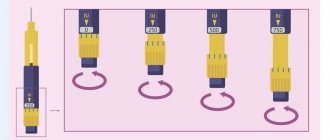How long does it take for Mifepristone to work?
It should be noted that only a qualified gynecologist can correctly calculate the dosage of the drug Mifepristone, as a rule, based on the duration of pregnancy and the weight of the woman.
The first dose of Mifepristone leads to endometrial rejection and dilatation of the cervix. To assess the body's response to the action of Mifepristone, the patient must remain under the supervision of a doctor for several hours.
You should visit the gynecological clinic for the second time after 36–48 hours. Having assessed the woman’s condition, the doctor may prescribe the drug Misoprostol, under the influence of which the uterus begins to actively contract. In most cases, after taking Misoprostol, pregnancy ends within six to eight hours. After 10–14 days, it is necessary to undergo a gynecological examination and ultrasound control again to ensure that the miscarriage has occurred and that there are no complications.
Preparation for the procedure
When you first visit a gynecologist, you need to conduct a general examination, a bimanual examination on a chair and in mirrors, and vaginal smears are taken. Blood pressure, pulse, and respiratory rate are also measured. Next, the woman is sent for an ultrasound to determine the exact day of gestation, the condition of the uterus, and the fertilized egg.
Referrals are given for blood, urine, glucose, and ECG tests. A coagulogram is prescribed if there is a history of problems with the blood coagulation system. Additional examination methods may be needed, the need for which is determined by the doctor.
When visiting the obstetrician-gynecologist again, the patient signs consent to perform an induced abortion using pharmacological drugs.
The signs of an abortion are identical to a spontaneous miscarriage. A woman feels a cramping stomach ache and menstrual-like discharge appears.
How long does the bleeding last?
For most women, it lasts 7-9 days. Blood discharge after the procedure is rarely observed until the next menstruation. If the manipulation is carried out for a period of 3-4 weeks, then bleeding is not much different from menstruation. As the period increases, the release of blood increases; sometimes the use of hemostatic therapy may be required.
After 14 days you need to appear for a follow-up examination. This is necessary to confirm that the interruption has occurred. If an unsuccessful medical abortion occurs, aspiration from the uterus is prescribed.
Mifepristone contraindications
- Probability of tubal pregnancy
- Gestation period more than 6 weeks
- Scars, tumors on the uterus, sexually transmitted infections
- Complex anemia
- Adrenal and liver failure
- Taking medications that reduce blood clotting
- Pregnancy while taking contraceptives
- Smoking over 35 years of age (doctor's consultation required)
Mifepristone tablets are sold exclusively to doctors. At the Health MC, medical abortion is performed in modern, comfortable conditions by specialists of the highest category.
How is the time for an abortion determined?
The timing for medical abortion is determined by the protocol of the Ministry of Health of the Russian Federation dated October 14, 21015. They record that it is possible to carry out a gestational disorder up to 63 days, or the 9th week. But in world practice there are differences in how long this manipulation can be done. In developed countries, the period is defined as 49 days, or 7 weeks of pregnancy.
Why is such a period determined for pharmacological interruption?
At the 5th week of pregnancy, the embryo begins to acquire human features, the rudiments of many organs and the umbilical cord appear. At week 6, the placenta begins to form, and internal organs continue to develop. At week 8, the embryo already has a completely human appearance and enters the fetal stage. After this period, the formation of blood vessels in the placenta occurs, so a medical abortion can cause heavy bleeding.
The following drugs for medical abortion are registered and used in Russia:
1. Mifepristone 200 mg.
2. Misoprostol 200 mcg.
Pharmacological abortion during a frozen pregnancy can be used if the gestational age corresponds to that permitted by the protocol. The main condition for the successful completion of the procedure is the day of pregnancy and the presence of an embryo inside the uterus according to ultrasound results. After a caesarean section, the medical method is preferable to other methods.
Medication termination of early pregnancy
One of the most important problems of modern healthcare is the preservation of women's reproductive health. Such close attention to this problem is connected, first of all, with the demographic situation in Russia. The measures taken, unfortunately, do not increase the birth rate in our country to the required level. The main way to solve the problem of preserving the reproductive function of women is to reduce the number of medical and criminal abortions and prevent unwanted pregnancies.
In the Russian Federation, abortion continues to be a common method of birth control and family planning (V.I. Kulakov, 1993). According to medical statistics, every year about 15-20 thousand women terminate their pregnancies. Until the last decade, surgical methods of abortion were used, such as vacuum curettage, vacuum aspiration (“mini-abortion”) and traditional curettage.
Vacuum curettage is the most common method of artificial abortion in many countries of the world, including Russia. The advantages of this procedure are the simplicity and short duration of the procedure for complete evacuation of the contents of the uterine cavity through a slight dilatation of the cervix. The operation is easily performed under local anesthesia on an outpatient basis.
When using this method of abortion, allergic reactions to the medications used, perforation or atony of the uterus, convulsions or cardiac arrest, etc. are possible.
Artificial termination of pregnancy using vacuum aspiration for the purpose of birth control has become widespread in many countries of the world. The widespread use of this method is due to the fact that the operation can be performed on an outpatient basis using relatively simple medical equipment, subject to the rules of asepsis and antisepsis, without the use of local anesthesia. After the operation, patients return to normal activities within 1 hour. Despite the advantages of this method, diagnosing the initial stages of pregnancy and excluding ectopic pregnancy pose some difficulties.
Traditional curettage is an artificial abortion operation, which is currently used less and less. Medical abortion often leads to serious complications in the early postoperative period (bleeding, infection, remnants of the fertilized egg, etc.). At a later date, inflammatory diseases of the female genital organs, miscarriage, infertility, and ectopic pregnancy develop. The complicated course of subsequent pregnancy, childbirth and the postpartum period (V.I. Kulakov et al., 1991; T.N. Melnik et al., 2001) adversely affects the condition of the fetus and newborn (T.S. Cherednichenko, 2001).
Among the modern gentle methods of terminating an unplanned pregnancy, we can mention the medication method. Its development began back in the 70s. XX century. During this period, a program to create steroids with antihormonal effects was implemented in France. In 1980, mifepristone was introduced, which is a synthetic steroid drug for oral use and is an antagonist of progesterone and glucocorticoids.
The medical method of terminating an unplanned pregnancy using the drug mifepristone (Mifegin, Pencrofton) has been used abroad since 1980, and in Russia since 1998 (E. N. Karaeva et al., 1999).
Mifepristone (mifegin, pencrofton, mifeprex) is a synthetic steroidal antiprogestogenic agent (blocks the action of progesterone at the receptor level). The mechanism of action of the drug is based on interaction with the hormone-binding domain of the target cell receptor, which causes an “ineffective” conformation and blockade of the effects of the natural steroid.
Mifepristone increases the contractility of the myometrium, stimulating the release of interleukin-8 in choriodecidual cells, increasing the sensitivity of the myometrium to prostaglandins (to enhance the effect, it is used in combination with synthetic analogues of prostaglandins (E. N. Karaeva et al., 1999)). As a result of the action of the drug, desquamation of the decidua and the removal of the fertilized egg occur.
After a single oral dose of 600 mg of mifepristone, the maximum concentration is reached after 1.5 hours. The absolute bioavailability of the drug is 69%. In blood plasma, mifepristone is 98% bound to proteins: albumin and acidic alpha-1-glycoprotein. After the distribution phase, elimination is slow at first, the concentration decreases by half between 12-72 hours, then the elimination process accelerates. The half-life is 18 hours.
During a pathomorphological study of the material from miscarriages (T. N. Melnik et al., 2001) after the use of mifepristone, they found that the line of rejection of the developing placenta passed along the terminal ends of the anchor villi and residual fragments of the basal membrane, consisting of layers of cytotrophoblast and decidual cells. In the cavity of the embryonic sac, preserved fragments of the embryo, amniotic membrane and yolk sac were found. There was a complete correspondence of the structure of the villi, as well as the wall of the embryonic sac, which was explained by the short period from the moment of taking the drug to the rejection of the embryonic sac. The immediate mechanism of rejection was the formation of a hematoma in the thickness of the basal lamina with its transition to the nearby intervillous space. The local nature of hemorrhagic disorders (at the border of the endo- and myometrium), their acute occurrence and the short duration of the process did not create prerequisites for the release of thromboplastic masses and, consequently, for changes in hemostasiological parameters of the blood, which was confirmed by a study of the blood coagulation system.
The current indication for the use of mifepristone (mifegin, pencrofton) is termination of intrauterine pregnancy in the early stages (42 days of amenorrhea). However, there are studies (R. A. Hatcher, 1993; R. A. Manusharova, E. I. Cherkezova, 2002), during which these drugs were used before 9 weeks of pregnancy. In addition, literature data indicate the effectiveness of using mifepristone for the preparation and induction of labor during full-term pregnancy. Currently, mifepristone is used in France, the USA, Sweden, China, Russia, Great Britain, India and other countries.
Contraindications to the use of the drug are: a history of hypersensitivity to mifepristone, adrenal insufficiency and long-term glucocorticosteroid therapy, acute or chronic renal and/or liver failure, porphyria, uterine fibroids, presence of a uterine scar, anemia, hemostasis disorders (including as a result of previous treatment with anticoagulants), inflammatory diseases of the female genital organs, the presence of severe extragenital pathology. Mifepristone should not be used in women over 35 years of age who smoke without first consulting a physician. In addition, contraindications to the use of the drug for the purpose of abortion are suspected ectopic pregnancy; pregnancy not confirmed by clinical studies; exceeding 42 days after the cessation of menstruation; occurring during the use of intrauterine contraception or after discontinuation of hormonal contraception.
The drug should be prescribed with caution for chronic obstructive pulmonary diseases (including bronchial asthma), severe arterial hypertension, cardiac arrhythmias and heart failure. Patients with prosthetic heart valves or infective endocarditis should be treated with prophylactic antibiotics while receiving mifepristone.
Breastfeeding should be stopped for 14 days after taking mifepristone. The use of this drug requires all preparatory measures related to abortion.
Among the side effects associated with the termination procedure, it should be noted: bloody discharge from the genital tract, pain in the lower abdomen, exacerbation of inflammatory processes of the uterus and appendages.
Side effects associated with taking mifepristone are a feeling of discomfort in the lower abdomen, weakness, headache, nausea and vomiting, dizziness, hyperthermia. Taking mifepristone in a dose of up to 2 g does not cause adverse reactions. In cases of drug overdose, adrenal insufficiency may occur.
When performing a medical abortion using the drug mifepristone, you should avoid prescribing non-steroidal anti-inflammatory drugs, as they weaken its effectiveness. If on the 10th–14th day there is no effect from the use of the drug, the pregnancy must be terminated in another way, since the formation of congenital malformations in the fetus is possible.
Studies conducted back in the 80s showed that the effectiveness of the isolated use of mifepristone is 85%. Therefore, it was subsequently proposed to combine mifepristone with prostaglandins. According to the literature, the effectiveness of this combination reaches 96-98% (R. A. Manusharova, E. I. Cherkezova, 2002). It has also been shown that the effectiveness of the combined use of mifepristone (at a dose of 400 mg) and Cytotec (800 mcg) is 96%.
We observed 200 women aged from 18 to 41 years (36.7+2.3 years). For 37 of them, it was their first pregnancy; 28 had terminated their second pregnancy (the first ended in an induced abortion), the rest had a history of childbirth (37) or childbirth and abortion (98). According to gynecological examination and ultrasound, the average gestational age was 5.2±0.2 weeks with an average diameter of the ovum of 10.5+0.5 mm.
Gynecological diseases were present in 42.1% of patients (asymptomatic small uterine fibroids - 4.1%; cervical erosion - 20.9%; chronic adnexitis - 15%; paraovarian cyst - 4%; ovarian dysfunction - 5%; genital endometriosis - 3.1%).
Mifegin was prescribed once in the form of tablets at a dose of 600 mg (3 tablets of 200 mg each), and after 36-48 hours the patients took a prostaglandin - misoprostol (Cytotec) at a dose of 400 mcg (2 tablets of 200 mcg each) and after 3 hours - another 400 mcg (2 tablets). The drugs were taken in the presence of a doctor after obtaining the patient's consent. Observation was carried out for 2-3 hours, after which women could leave the medical facility after receiving the necessary recommendations. The ability to work was completely preserved.
The effectiveness of the method was assessed on the basis of a positive outcome, confirmed by data from an objective examination, bimanual examination, and ultrasound (absence of the fertilized egg, as well as its elements in the uterine cavity on the 10-14th day).
Expulsion of the ovum in 180 out of 200 women occurred after the combined use of Mifegin and Cytotec, in 11 patients - without additional use of Cytotec. In 9 patients with a gestational age of 8.5-9 weeks. 12-24 hours after taking mifegin, bleeding from the genital tract was observed, for which they were hospitalized and the uterine mucosa was curetted. Expulsion of the gestational sac occurred on the first day after taking Cytotec in 95.3% of women, and on the second day in 4.7% of women. Clinically, this was manifested by bloody discharge from the genital tract (scanty or moderate intensity) on the first day after taking mifegin - in 38% of women; 62% of patients did not experience any bleeding from the genital tract on the first day after taking mifegin. 40–55 minutes after taking Cytotec, bleeding from the genital tract intensified in the vast majority of women and in 60% of cases was accompanied by cramping pain in the lower abdomen and expulsion of the ovum.
The duration of bleeding was in most cases from 7 to 14 days. In 4 patients, scanty bleeding was observed for up to 15-17 days. Bleeding that required conservative therapy for 1-2 days (dicinone, ascorutin, vikasol) was observed in 3 patients. Surgical intervention for the purpose of hemostasis was not required in any observation. It should be noted that severe cramping pain in the lower abdomen was observed in nulliparous women, and in women who gave birth they were weakly expressed or absent. Cramping pain in the lower abdomen was relieved by oral administration or parenteral administration of antispasmodic (no-spa) or analgesic (analgin, baralgin) agents.
We were unable to achieve a positive result after taking Mifegin in 3 cases. According to ultrasound data, the presence of remnants of the fertilized egg in the uterine cavity was recorded, for which the patients underwent diagnostic curettage. It should be noted that these women had a history of endometritis. Apparently, the lack of sufficient effect in these cases is due to impaired contractility of the uterus.
Mifegin was well tolerated. When taking Cytotec, 8 women experienced side effects (in the form of nausea, vomiting, dizziness, headache), which lasted for 30-45 minutes from the start of taking the drug and went away on their own.
Control ultrasounds performed on days 10-14 after expulsion of the ovum showed normal endometrial condition in 187 women. In 3 patients, expansion of the M-ECHO was noted in the presence of hypoechoic content. In one observation, heterogeneity of M-ECHO and echo-negative inclusions were revealed. These women were additionally prescribed duphaston at a dose of 10 mg 2 times a day for 10 days and an additional ultrasound was performed after the next menstruation. In all cases, the normal state of M-ECHO was established during control ultrasound.
Thus, the results of the study indicate that the combined use of the drugs Mifegin (mifepristone) and Cytotec is a highly effective means for terminating an unwanted pregnancy. If all necessary requirements are strictly observed, this method is well tolerated by women, has no significant side effects and can be used to terminate pregnancy at short notice (up to 7 weeks). The use of mifegin does not cause disruption of the menstrual cycle, the likelihood of affecting reproductive function is almost zero.
Medical termination of pregnancy almost completely eliminates the risk of ascending infection and associated complications. In addition, with this method of abortion, there is no psychogenic trauma, which most often accompanies traditional artificial abortion, which improves the woman’s quality of life.
For questions regarding literature, please contact the editor.
R. A. Manusharova , Doctor of Medical Sciences, Professor E. I. Cherkezova RMAPO, Andrology Clinic, Moscow








